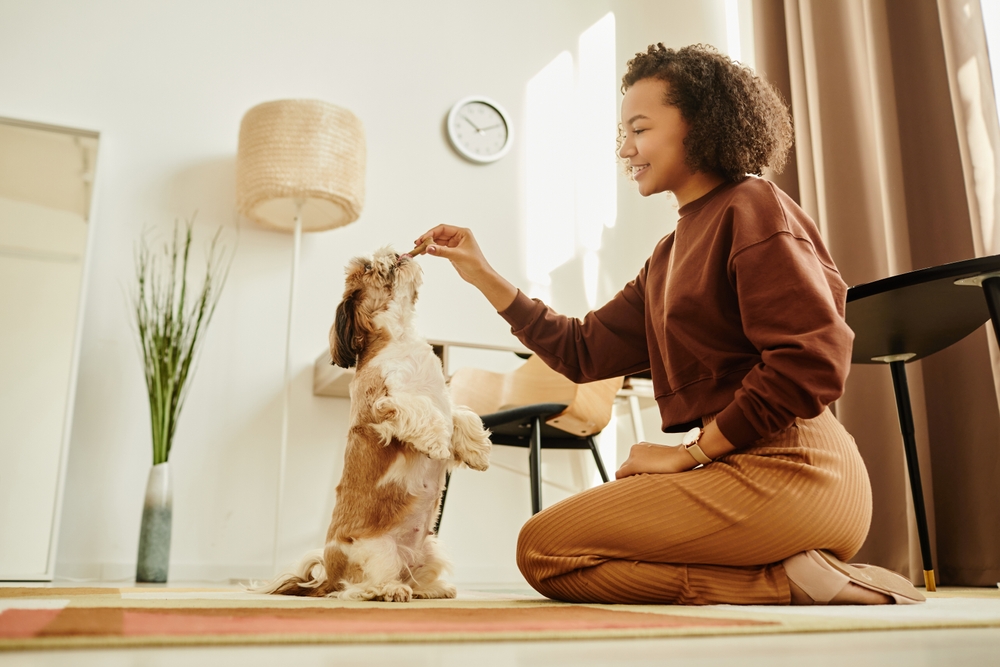People think that puppies are born knowing how to walk on a leash. However, all puppies need some form of training to learn this important skill properly.
Getting a puppy is an amazing time, full of excitement and joy, but it also comes with challenges. One of the first things you have to teach your new companion is how to properly walk on a leash. This task is easier said than done, but with the right technique and a lot of practice, every puppy will master this skill.
Training your puppy to walk on a leash is such a valuable skill, setting the stage for memorable outdoor adventures while encouraging great behavior. A well-trained puppy not only makes walks more enjoyable but also helps keep both you and your furry friend safe. This journey can be filled with excitement, but it also has challenges, as puppies are naturally curious and full of energy, always ready to discover the world around them. But with some helpful techniques and a little patience, leash training can become a truly rewarding experience.
Let’s explore together seven steps that will help you in the journey of training your puppy. By embracing these strategies, you’ll build a wonderful bond with your puppy, helping them develop great leash manners. This way, your walks will be enjoyable and stress-free for both you and your adorable companion!

1. Choose the Right Equipment
Selecting the proper equipment for leash training is important in order to make sure your puppy feels comfortable and that you have control. A lightweight leash, usually about 4 to 6 feet long, makes handling your puppy easier while allowing them to discover their surroundings. Choosing a cozy collar or harness is just as important. A harness sounds like a good idea since it does not put pressure on your puppy’s neck. However, for training reasons, it is better to start with a collar and switch to a harness when your pup is already leash-trained.
Choosing the right equipment is the first step. It not only boosts safety but also helps your puppy feel more confident during walks. If the gear is uncomfortable or restricted, your puppy might shy away from wearing it, making training a bit tougher. On the other hand, if a puppy does not feel the collar, it may be tempted to pull and play and not pay attention to your cues.
Using high-quality equipment might be a good idea as it stands up to all the tugging and chewing that our playful pups love. Investing in the right gear creates a positive walking experience that makes teaching your puppy good leash manners easier, all while strengthening the bond between you and your furry friend!
2. Start Indoors
Beginning leash training indoors is essential to creating a positive experience for you and your puppy. Indoors usually offer a quieter space, free from the many distractions outside, allowing your puppy to concentrate better on the training. This secure environment helps ease any anxieties your puppy might have, making it much easier to get used to wearing a leash and collar harness.
Training indoors creates a cozy and safe environment for you to develop essential skills without the distractions of outdoor sights, sounds, and smells. It allows you to practice basic commands and encourages positive behaviors, like walking happily beside you and responding to your cues. As your puppy builds confidence and starts to link the leash with fun experiences, you can smoothly shift to outdoor settings. This gradual approach lays an excellent foundation for successful leash walking, ultimately making those outdoor adventures even more enjoyable and relaxing for both you and your furry friend.
3. Positive Reinforcement
Positive reinforcement is vital in teaching your puppy to walk nicely on a leash. By rewarding and praising them, you encourage the behaviors you want to see. This approach helps your puppy develop a happy connection with the leash, making them more excited to take part in training. When you offer treats, affection, or kind words to your puppy for walking alongside you or following commands, they discover that these actions bring delightful rewards and playtime.
Positive reinforcement wonderfully strengthens the bond between you and your puppy, nurturing trust and encouraging them to follow your guidance enthusiastically. This gentle approach helps ease anxiety and fear, allowing your puppy to associate leash walking with joyful experiences rather than negativity. Plus, regular rewards help reinforce good habits, making it easier for your puppy to master proper leash manners as time goes on. Positive reinforcement creates a joyful training environment, leading to a happy, well-behaved puppy who looks forward to walking with you.
4. Keep Sessions Short
Short training sessions are key to teaching your puppy how to walk on a leash! Since puppies have short attention spans and lots of energy, keeping sessions around 5 to 10 minutes is a great way to keep their focus and excitement up. This way, you won’t overwhelm them with too much at once, and they can happily soak up all those new skills.
Keeping training sessions short helps both you and your puppy stay happy and engaged. When things drag on and become tedious, your puppy might lose interest or even become a little stubborn, making it challenging to reinforce those good behaviors. So, by wrapping up each session with a joyful moment, like a delightful walk or a fun command, you’ll leave your puppy excited and ready for the next adventure together.
Moreover, several brief sessions daily can prove more effective than a single long session. This approach helps reinforce skills while allowing your puppy to gradually develop confidence and understanding of leash walking.
5. Practice Loose Leash Walking
Teaching your dog how to walk on a loose leash is an essential skill that greatly helps take them to public places. When your puppy walks with a loose leash, it means there’s a bit of slack, letting them explore while still being close to you. This lovely way of walking helps prevent pulling and keeps you and your puppy safe and comfortable on your adventures together.
When you encourage your puppy to walk on a loose leash, you’re helping them learn to pay attention to your cues and keep a comfortable pace. This approach strengthens the bond between you and your puppy and sets the stage for positive habits from the start. If your puppy starts to pull, simply stop and wait for them to return to your side, which reinforces the idea that staying close leads to even more fun together.

6. Use Commands
Commands are essential for communicating clearly with your puppy in leash training. Commands such as “heel,” “let’s go,” and “stop” offer direction and outline behavior expectations during walks. Teaching these commands establishes a framework that helps your puppy understand what’s expected.
Regularly using commands helps establish good habits and keeps your puppy focused on you during walks. When your furry friend follows commands, it boosts its confidence and strengthens your connection. Also, teaching a puppy commands can redirect its focus if it gets distracted or overly excited.
Commands are essential for your pup’s safety. For instance, instructing your puppy to “sit” before you cross the street helps avoid accidents. Integrating commands into leash training creates healthy habits that will help you nurture a deeper bond and trust with your furry friend.
7. Gradually Introduce Distractions
Introducing distractions gradually is crucial for leash training. This allows them to concentrate on you among engaging stimuli in their surroundings. Puppy curiosity is innate, making them prone to distractions from animals, people, or noises. By progressively familiarizing them with these interruptions, you instill the ability to stay attentive and calm while walking.
Beginning in a calm, controlled setting lets your puppy gain confidence and master basic leash skills without being overwhelmed. As they grow more at ease, slowly introduce distractions like distant dogs or people. This step-by-step method encourages your puppy to obey commands and keep a loose leash, even amid tempting distractions.
Engaging in this practice strengthens positive behaviors and enhances your puppy’s self-regulation skills. In the end, slowly adding distractions results in more pleasant and secure walks, nurturing a robust connection between you and your puppy while promoting proper leash etiquette.
Training your puppy to walk on a leash can be a delightful journey when you approach it thoughtfully. Each of the steps above is key to creating a successful training experience. By nurturing a positive and structured environment, you’re not just teaching your puppy important skills; you’re also building a wonderful bond together. With a sprinkle of patience and consistency, your puppy will soon be looking forward to walks, turning them into joyful experiences that foster a lifetime of happy outdoor adventures for both of you.
Related article: First-Time Dog Owner? These 8 Breeds are the Perfect Choice.












